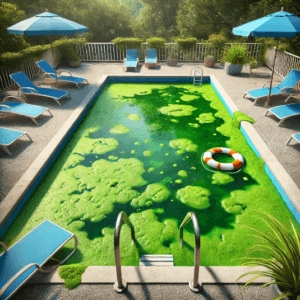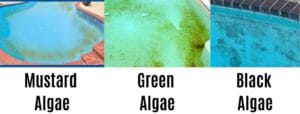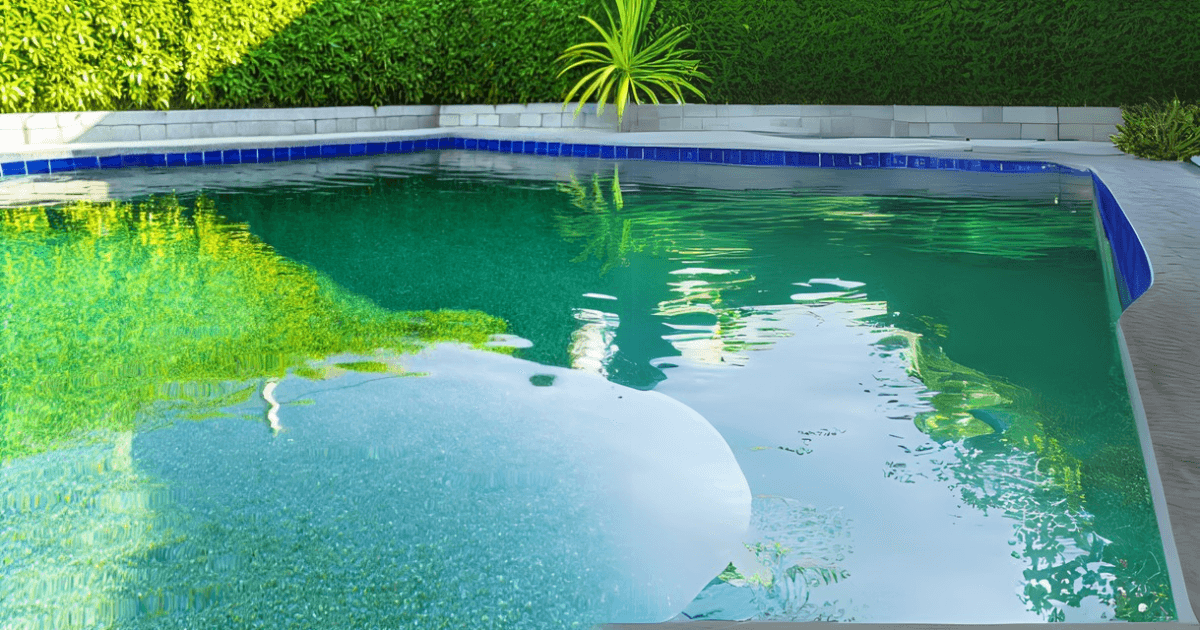Introduction
Unbelievably, that green tint in your pool might take you straight to the doctor! Apart from its ugly appearance, algae provide a habitat for harmful bacteria like Salmonella and E. Coli. I have witnessed how fast a neglected pool may become hazardous to your health. According to the CDC, thousands of infections among recreational water users result from contaminated pool water annually. The good news is that you and your family can stay safe if you know the risks and take action. This article will discuss how algae could cause illness and how you might keep healthy. Let’s dive in.

Understanding Pool Algae and Health Risks
Little creatures resembling plants and pool algae can easily transform your pristine pool into a green or cloudy nightmare. They grow in environments where the water’s chemistry is wrong, poor circulation, and inadequate cleaning. Many types of algae grow in your pools. Black algae create thick, dark areas that are most difficult to remove; yellow or mustard algae attach to walls and are not destroyed by chlorine; and green algae float around freely and may color the whole pool green.
When algae cells (which may be carried by wind, rain, or even unclean clothes) find a suitable habitat in your pool, they quickly develop. Warm water, plenty of sunlight, and little disinfectant concentration are the perfect growing conditions. Besides making your pool seem ugly, algae could contain bacteria that harm human health and expose swimmers to danger. Maintaining an eye on the chemical levels in your pool, ensuring the filter is operating as it should, and regular pool cleaning will help to prevent algae growth. Trust me; a little effort goes a lot toward keeping your pool safe and clean.
Can Algae in a Pool Make You Sick?

There’s no doubt that algae in a pool can make you sick. I have seen it happen numerous times. First, swimming in algae-rich water can worsen skin conditions and result in rashes. Red or itchy, very painful lumps left behind by ashes of algae may be found. Then, one runs the risk of developing eye problems. Certain algae may irritate the eyes and lead to redness or even conjunctivitis. For those with allergies or asthma, the situation can develop worse. Breathing in air close to algae-containing pools might lead to respiratory difficulties. Not least of all, consuming contaminated water could lead to stomach issues like diarrhea, cramps, or nausea.
Cryptosporidium, legionella, and norovirus commonly inflict those swimming in pool algae. Small children, older people, and anyone with preexisting medical conditions should avoid swimming in algae pools. You should also seek medical attention immediately if you’ve contracted a bacterial infection from algae in a pool.
Keeping your pool clean isn’t just about aesthetics and health. Regular maintenance prevents these problems and ensures everyone enjoys a safe swim.
Types of Algae Commonly Found in Pools and Their Characteristics

1. Green Algae
These are the most common culprits in pool algae problems. Green algae float freely, turning the water cloudy and giving it that uninviting green tint. Over the years, I’ve seen how quickly they can bloom, significantly when chlorine levels drop in warm weather. They thrive in poor circulation and inadequate filtration, impacting pool hygiene by harboring bacteria and making surfaces slippery. Keeping chlorine levels between 1-3 ppm and brushing the walls regularly helps keep them at bay.
2. Yellow (Mustard) Algae
This type is a bit trickier! Yellow algae cling to walls and shady areas, resembling pollen or sand. They’re resistant to chlorine, making them more challenging to eliminate. I’ve had clients struggle with these stubborn spores. The key is using a specialized algaecide and thoroughly cleaning all pool equipment and toys, as yellow algae can hide there. Persistence pays off when dealing with this one.
3. Black Algae
Now, black algae are the most formidable foes. They form dark spots with deep roots in plaster or concrete surfaces. Not only are they resilient, but they can also pose health risks by sheltering harmful organisms. I’ve tackled black algae infestations that required heavy brushing, super-chlorination, and even acid washing. It’s crucial to act fast and aggressively when you spot them!
Prevention and Treatment Strategies
Maintaining a shining, clean pool doesn’t have to be a difficult task! Avoiding algae growth mainly depends on keeping the correct pool chemistry. Frequent pH and chlorine level tests of the water guarantee a clean swimming environment. During peak season, I advise a minimum twice weekly assessment of these levels. Maintaining control is vital if chlorine levels decrease as algae develop rapidly. Although algaecides have great power, natural substitutes like barley straw extract can sometimes perform magic. Remember your filtration system; operating it for between 8 and 12 hours every day helps move chemicals and filter out trash. Your pool stays in great form if you plan a comprehensive cleaning once a week involving vacuuming, brushing, and skimming. Trust me; a little daily ritual goes a lot toward maintaining pool conditions! And if you ever find any green areas, react quickly with shock treatments to cut it in its tracks.
Conclusion
Maintaining a clean pool free of algae is about safeguarding your health and the welfare of others who dive in, not just glistening clean water. I have often seen how a little preventative treatment may stop major diseases connected to these microscopic invaders. Thus, let’s make pool upkeep and maintenance a regular habit: routinely test your water, maintain your filtration system running, and address any green areas when they first appear. You will find that these few actions make all the difference. Let’s make your pool the secure, glittering refuge it was designed to be!
Frequently Asked Questions (FAQs)
1. Is algae in the pool harmful to humans?
Algae doesn’t usually hurt people but provides a home for germs that can cause illnesses.
2. Can I swim in a pool that has algae?
It is usually not safe to swim in a pool with algae. Algae can make the floors and walls of pools more slippery, which raises the risk of slips and falls.
3. What are the symptoms of swimming pool bacteria?
Bacteria in swimming pools can make you sick with watery diarrhea, stomach cramps, sickness, and fever. In more severe cases, people may become dehydrated and lose weight. People who have these symptoms, especially diarrhea, should not go swimming to keep the virus from spreading to other people.
4. Can inhaling algae make you sick?
Yes, breathing in water drops or fumes from water that is full of algae can make your lungs hurt.
5. How long does algae poisoning take?
The first signs of algae toxins can show up at different times. Symptoms of a liver problem can appear anywhere from a few hours to a few days later and include stomach pain, diarrhea, and vomiting. Neurotoxic responses can happen more quickly, usually within minutes to an hour of contact. They can cause headaches, seizures, and dizziness.






